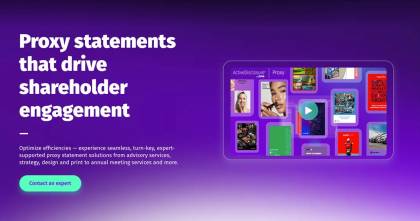The proxy is an ever-changing element of the business environment, with new disclosure trends appearing suddenly that require immediate attention from your board (ESG, anyone?). Keeping everything straight for the benefit of the SEC while still producing a proxy that excites your shareholders is a major challenge for even small-cap businesses.
Thankfully, we've assembled an experienced team of panelists to help guide you through this year's proxy season:
- Danielle Benderly, Partner, Perkins Coie
- Jens Fischer, Partner, Perkins Coie
- Allison Handy, Partner, Perkins Coie
- Broc Romanek, Strategist, Perkins Coie
- Ron Schneider, Director of Corporate Governance Services, DFIN
They shared their thoughts on 17 proxy sections in a one-hour webinar entitled "Anatomy of a Proxy: Practice Tips from the Experts", which is available above. Take some time to watch and learn from our experts, along with some sample proxy disclosures taken from some of the world's leading businesses.
Here are a few of the highlights and don't forget to watch the entire free webinar for more!
Key Takeaways:
Summarize creatively. Romanek emphasizes that summaries are a great place to take advantage of proxy design. "A picture is worth a thousand words," he says. A well-designed graphic can communicate 10 pages worth of data.
But Benderly also advises caution. "[Some graphics] can include non-GAAP financial information that is subject to regulatory compliance," she says. Make sure these graphics are double-checked before moving forward.
No response isn't always bad. It's entirely possible that your biggest investor won't respond to your engagement outreach efforts (especially true for smaller businesses). It might be frustrating, but it's not a reason to panic. "The good news is that your big investors – Blackrock etc – do keep track of whether you reach out," says Schneider. "So you do get partial credit. It may be frustrating, but that doesn't mean it should be a deterrent from trying."
So keep reaching out! A quiet audience can still be an appreciative one.
The new spotlight. Board Risk Oversight has quickly gained importance in the last few years. "It's become one of the most important sections in the proxy disclosure, one focused on more and more by shareholders and the SEC," says Fischer. "Especially since COVID and the rise of ESG."
Boards have more and more committees that cover separate and important risks, especially around cybersecurity and ESG. Your proxy needs to show readers the process that governs these committees.
The do's and don'ts of ESG disclosure. Handy points out that more and more companies are including an ESG section in the proxy. While this area is still developing, Handy provided an illuminating list of 4 "things to do" and 3 "things to NOT do" in your ESG disclosure (skip to 18:40 to hear her complete list).
Show your face! Fischer strongly encourages more visual disclosure when it comes to Director Nominees. Shareholders of both big and small companies have expressed a preference for photos, graphs, matrices, and other visuals.
"This has been a big factor for investors and other readers of the proxy," says Fischer. "This year, what's going to be front and center is board diversity information."
Get the right advice. Benderly advises against using the consulting arms of an institutional advisory group. "My experience is that it's not always as useful as the advice you're going to get from a compensation consultant or a proxy solicitor," she says.
Handle with care. How should you handle a shareholder proposal? Handy offers one tip: draft a short, to-the-point statement in opposition immediately. Start framing it as soon as you get the proposal. "That can help you decide if you're going to negotiated with the shareholder or if you're going to seek no-action relief," she explains.
Attendance mandatory? With COVID concerns still looming, companies are in two camps this year: those who want to return to an in-person meeting and those who want to keep it virtual.
Handy advises that, if you're keeping your meeting virtual, you need to think about how to express your reasoning to your shareholders. Make sure to address all the hot button issues people have with virtual meetings.


